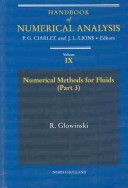This book-size article is dedicated to the numerical simulation of unsteady incompressible viscous flow modelled by the Navier-Stokes equations, or by non-Newtonian variants of them. In order to achieve this goal a methodology has been developed based on four key tools. Time discretization by operator-splitting schemes such as Peaceman-Rachford's, Douglas Rachford's, Marchuk-Yanenko's, Strang's symmetrized, and the so-called "theta-scheme" introduced by the author in the mid-1980s. Projection methods (in L2 or H1) for the treatment of the incompressibility condition div u = 0. Treatment of the advection by: either a centered scheme leading to linear or nonlinear advection-diffusion problems solved by least squares/conjugate gradient algorithms, or to a linear wave-like equation well suited to finite element-based solution methods. Space approximation by finite element methods such as Hood-Taylor and Bercovier-Pironneau, which are relatively easy to implement.
In addition to the above topics the article contains detailed discussions of conjugate gradient algorithms, least-squares methods for boundary-value problems which are not equivalent to problems of the calculus of variations, Uzawa-type algorithms for the solution of saddle-point problems, embedding/fictitious domain methods for the solution of elliptic and parabolic problems. In fact many computational methods discussed in this article also apply to non-CFD problems although they were mostly designed for the solution of flow problems. Among the topics covered are: the direct numerical simulation of particulate flow; computational methods for flow control; splitting methods for viso-plastic flow a la Bingham; and more. It should also be mentioned that most methods discussed in this article are illustrated by the results of numerical experiments, including the simulation of three-dimensional flow. Due to their modularity the methods described in this article are relatively easy to implement - as is demonstrated by the fact that several practitioners in various institutions have been able to use them ab initio for the solution of complicated flow (and other) problems.
- ISBN10 0444512241
- ISBN13 9780444512246
- Publish Date 25 July 2003
- Publish Status Active
- Publish Country GB
- Publisher Taylor & Francis Ltd
- Imprint Elsevier Science Ltd
- Format Hardcover
- Pages 1080
- Language English
